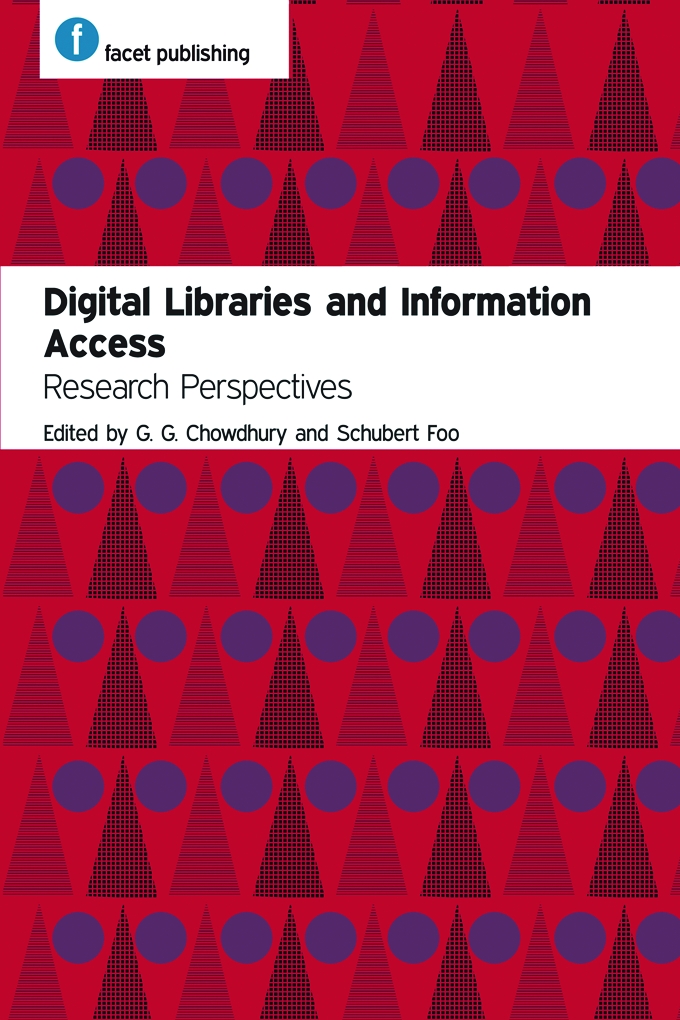Book contents
- Frontmatter
- Contents
- Foreword
- Editors and contributors
- 1 Digital libraries and information access: introduction
- 2 The design and architecture of digital libraries
- 3 Metadata and crowdsourced data for access and interaction in digital library user interfaces
- 4 Information access
- 5 Collaborative search and retrieval in digital libraries
- 6 The social element of digital libraries
- 7 Towards socially inclusive digital libraries
- 8 Users’ interactions with digital libraries
- 9 Digital libraries and scholarly information: technology, market, users and usage
- 10 Digital libraries and open access
- 11 iSTEM: integrating subject categories from multiple repositories
- 12 The usability of digital libraries
- 13 Intellectual property and digital libraries
- 14 Digital preservation: interoperability ad modum
- 15 Digital libraries and information access: research trends
- Index
- Miscellaneous Endmatter
12 - The usability of digital libraries
Published online by Cambridge University Press: 08 June 2018
- Frontmatter
- Contents
- Foreword
- Editors and contributors
- 1 Digital libraries and information access: introduction
- 2 The design and architecture of digital libraries
- 3 Metadata and crowdsourced data for access and interaction in digital library user interfaces
- 4 Information access
- 5 Collaborative search and retrieval in digital libraries
- 6 The social element of digital libraries
- 7 Towards socially inclusive digital libraries
- 8 Users’ interactions with digital libraries
- 9 Digital libraries and scholarly information: technology, market, users and usage
- 10 Digital libraries and open access
- 11 iSTEM: integrating subject categories from multiple repositories
- 12 The usability of digital libraries
- 13 Intellectual property and digital libraries
- 14 Digital preservation: interoperability ad modum
- 15 Digital libraries and information access: research trends
- Index
- Miscellaneous Endmatter
Summary
Introduction
Simply stated, the term ‘usability’ means how easily a product or a service can be used. In the context of digital libraries, usability studies involve both user studies and evaluation of digital library products and services. A number of models of usability have been proposed in the literature. However, usability studies originated in, and have been largely conducted in the context of, the field of human–computer interactions (HCI). Hearst (2009) comments that usability is an important quality of a user interface. Nielsen (2003, 2006) comments that usability depends on five qualities of the interface of an information service: learnability, efficiency, memorability, errors and satisfaction. These parameters focus on measuring the features of user interfaces and are built on the design guidelines of user interfaces proposed by Shneiderman and Plaisant (2010).
However, the usability of a digital library is not limited to its interface features; rather, it should focus on the overall digital library service. Kuniavsky (2003) suggests that there are four major steps in a usability study of information systems:
Define the users and their goals.
Create tasks that address these goals.
Select a group of study participants for the usability study.
Watch them try to perform the specified tasks using the service or product whose usability is being measured.
While these guidelines may be used for conducting usability studies of digital libraries, a number of challenges are involved here. This chapter addresses these issues and, drawing examples from several usability studies, it discusses different approaches and techniques for conducting usability studies of digital libraries. Some socio-economic issues affecting the usability of digital libraries, such as the digital divide and emerging business models, are also mentioned.
Usability
ISO 9241 Part 11 (1998) defines usability as the extent to which a product can be used by specified users to achieve specified goals with effectiveness, efficiency and satisfaction in a specified context of use. This definition reminds us that the users should be able to use an information product or service with effectiveness, efficiency and satisfaction in a specified context of use.
- Type
- Chapter
- Information
- Digital Libraries and Information AccessResearch perspectives, pp. 167 - 178Publisher: FacetPrint publication year: 2012



